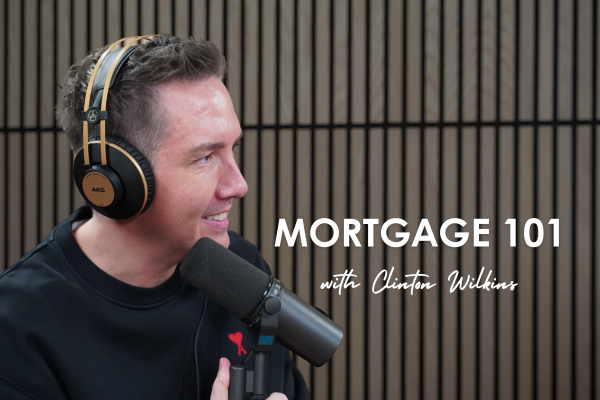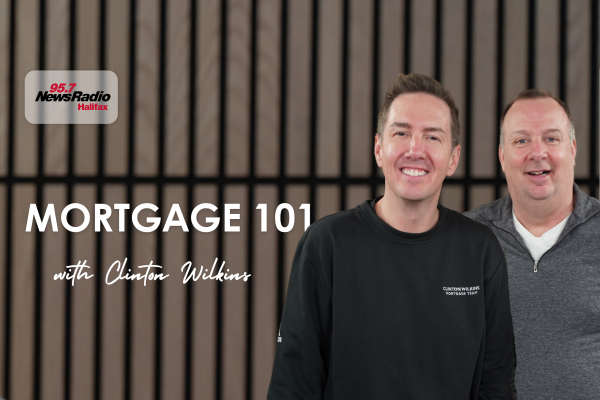Sandi Burns, Chief Credit Officer at Manulife Bank, joins Clinton and Todd to discuss her role in setting mortgage guidelines and managing the lending portfolio while highlighting Manulife's unique mortgage product.

Mortgage 101 – How Financial Institutions are Fighting Fraud
Sandi Burns, Chief Credit Officer at Manulife Bank, joins Todd and Clinton to discuss the increasing prevalence of mortgage fraud, the importance of regulatory compliance and evolving landscape of mortgage fraud.
Todd Veinotte
Sandi, welcome back to Mortgage 101: Your guide to home ownership with Clinton Wilkins and myself, Todd Veinotte and our guest, Sandi Burns from Manulife Bank. For those who are just tuning in, who might have missed the last segment, what’s your job title?
Sandi Burns
Chief Credit Officer.
Clinton Wilkins
That sounds very important.
Todd Veinotte
So you need to be on your good side if you want to get a mortgage with your bank.
Sandi Burns
Well, at least from a policy perspective, that’s right.
Fraud Awareness and Mortgage Lending Challenges
Clinton Wilkins
What we were talking about during the break about Fraud Awareness Month, which just passed in March, and it’s such a topical subject right now. Obviously, as the economy, it’s more challenging, and as house prices increase, it is just such a forefront of what I do every day. And there are different, obviously, different types of fraud. There’s fraud for profit, fraud for shelter, and if we’d never thought it impacted us here in Atlantic Canada, we would see maybe, like, one fraud file. And when we say fraud file, we mean it’s suspected fraud, because it’s not fraud until it’s proven in court that it’s fraud, right? But we would see one file maybe a year. But it’s certainly becoming more and more prevalent here in Atlantic Canada, and I know in Ontario and obviously in the West, it’s just rampant, especially when it comes to mortgage lending. Sandi, like, what insights can you give us on that?
Sandi Burns
Yeah, it’s interesting. We saw a big spike in fraud for shelter when interest rates were high, which I mean, fraud for shelter. So that means I’m trying to buy my house, and I can’t quite qualify, so maybe I can up my income statement in some way, shape or form, or some bank statement. So it is, it’s usually an individual or a very small scale.
Todd Veinotte
How often do you see that, by the way? Is that quiet? I wouldn’t think that’s very, maybe it’s more common than I think it is.
Sandi Burns
It is, I wouldn’t say it’s like an everyday thing, but it is probably more common than you think.
Clinton Wilkins
If you hear about the cab driver making $200,000
Sandi Burns
You got it, and then the other piece is, do all the documents tell the same story? So we don’t ask for just one piece of paper. When you’re, say, buying a house, there is your full purchase and sale agreement, there’s proof of your down payment, there’s proof of your current income, there’s your credit bureau, there’s, , all of these pieces exactly. And we, if we’re reviewing these all together, you can start to cobble together a story. And when I led an underwriting team, I always, always told them, if your spidey senses are tingling, chances are something, something’s up, right?
Todd Veinotte
So you’re saying that people will actually doctor, like Photoshop or whatever document.
Sandi Burns
They can get pretty, pretty high tech with it.
Todd Veinotte
You may or may not want to answer this gets sneaks one by,
Clinton Wilkins
I don’t know. I mean, you don’t know, I guess, unless there’s a loss.
Sandi Burns
And it is, I would say, fraud for shelter.
Clinton Wilkins,
It is 100% illegal.
Sandi Burns
Yes, yeah, where we have the additional challenge is when you have fraud rings. So you mentioned fraud for profit, and that’s when it gets really scary, because then it’s not just a one-off mortgage, then it’s probably a group of mortgages, and you can be looking at millions and millions of dollars that are at risk.
Todd Veinotte
So, what type of organization would be orchestrating fraud for profit? Organized crime, organized, I mean, is it like just any tangible thingy, or is it a group, or is it, I think.
Clinton Wilkins
There have to be multiple bad players involved. Sometimes there could be a mortgage broker, appraiser, lawyer, or realtor. It’s not just one person creating these frauds, especially if we’re talking about something on that scale, there would need to be multiple players involved to kind of pull something like that off. That’s exactly it. Yeah, and sometimes we see files coming from out of province and from clients we don’t know, or brokers are trying to refer to us that we don’t know. And we don’t do that specifically, because I want to know who the customer is, and we’re really about that advice piece, but I’m sure it happens all the time. And you’re like, Oh, here’s a full package of documents. Well, why is the client not calling me directly? They just ask more and more questions.
Sandi Burns
That’s it.
Clinton Wilkins
Yeah, especially since we see these are closing in 10 days, right?
Sandi Burns
And it’s like, but the purchase agreement may have been signed, like, three months ago or something. And you’re like, Well, why all of a sudden? Is it a rush? Did you really sign a purchase agreement without any conditions and no financing in place? I doubt it. And so then you start to ask a few more questions.
Todd Veinotte
So, how bad does the fraud get that people try and make up jobs?
Sandi Burns
You can see just about anything. The most, most typical is altering.
Clinton Wilkins
A little, usually the income or down payment, you got it?
Sandi Burns
Yeah, down payment is usually the most common, and then the income for qualifying.
Todd Veinotte
Well, at some point, though, you’re gonna have to justify that. You’re gonna pony up with them, though, if you’re a fraud.
Government Programs and Down Payment Rules
Clinton Wilkins
If you’re misrepresenting, we’ll call it misrepresenting instead of fraud, if you’re misrepresenting the down payment. But maybe that down payment is coming from the proceeds of crime. Oh, I see they’re trying to legitimize the down payment. And then, washing the money to try to make the down payment. It’s very, very common.
Todd Veinotte
All right, so what are the rules when it comes to down payment? Because you and I had a conversation, some government programs will assist with the down payment. So what are, what are some of the rules for down payment?
Sandi Burns
The money has to be in a Canadian financial institution, and it has to have passed kind of all the anti-money laundering rules. So it goes through a suspicious transaction with track, thin track, whatever financial institution it’s with, they’re going to verify those funds. And so we typically like to see it sitting in a bank account for like 90 days, a Canadian bank account. If it’s a gift letter, it has to be from an immediate family member. And the mortgage insurers out there, the default insurers, they define immediate family a little bit differently, but usually it’s someone like your mom or dad or brother, sister, brother, sister, exactly right, and it has to be an actual gift, so you can’t have to pay me back, , after three months or so.
Clinton Wilkins
Just imagine if the gift is not a gift, and it’s a loan that worsens your financial position, where maybe you have to make a payment on this. And I see this all the time.
Todd Veinotte
Well, how would you police that? Though police might not be the right term, how do you monitor that? Because if somebody has a side deal, then you don’t know, right?
Sandi Burns
The big challenge is that we have our gift letter, and the gift letter clearly, explicitly says this is a gift if, at the end of the day, they’re like, sliding something behind it.
Todd Veinotte
They’re gonna have to deal with that at all. They’re not helping themselves. They’re not helping.
Clinton Wilkins
This is why, like lenders like Manulife Bank, who work with brokers like we’re licensed in the province of Nova Scotia, we also have to do our due diligence to make sure that we are presenting these files correctly to the bank. It’s our job to protect the bank just as much as it’s the bank’s job to protect itself.
Todd Veinotte
Well, I would think that that’s why relationships like yours with your lenders are very valuable, very valuable because they trust you.
Clinton Wilkins
It’s an extra layer of, I think, security and compliance, and that’s really why these lenders are willing to pay us. We’re onboarding new clients to you, but we’re doing a lot of this work to package these files, make sure they’re approved, get them to the finish line, et cetera, et cetera. Make sure it’s compliant because we wouldn’t be in business if we didn’t have lenders like Manulife Bank, for example, if we didn’t have Scotiabank, if we didn’t have TD Bank, we would not have a business. And that’s why it’s so important that these bank lenders are here, really in our channel, because there are so many other lenders out there, but a lot of these other lenders are funded by these banks.
Todd Veinotte
At what point do you determine that law enforcement should be involved?
Sandi Burns
So that is outside of my view. Usually, it’s got to be a big one. And I think that’s where you get into the fraud for profit.
Todd Veinotte
So, although it is illegal if somebody misrepresents an intent, intending to falsify a document. Generally, you probably just disqualify them for the mortgage rate, yes,
Sandi Burns,
We would market to customers.
Clinton Wilkins
They could exit the relationship, and this may not, but just be like, Hey, we’re not doing this mortgage for you. Yeah, we are going to just not do business with you at all.
Todd Veinotte
Now, is there a portal or something that their names go into a database that those names go on?
Sandi Burns
So if it is, say, a broker or an appraiser or a realtor, then yes, there is, there is Castle, that’s right, and it is monitored lawyers we are always checking the the Bar Association to make sure that lawyers don’t have any black builders are another, yeah, we can monitor there.
Clinton Wilkins
So many bad players out there. And it’s, I mean, it must be just daunting from a bank perspective, to make sure that the people that you’re doing business with are people that you want to be doing business with. The reputational risk is just so high, yeah, like, imagine if the bank does a mortgage, and then there is some reputational risk that can be tough, because the bank doesn’t want their name in the media saying, Hey, we did these mortgages.
Todd Veinotte
Yeah. And I would think that if, as times get more desperate financially for people, you’re going to see people taking more risks.
Consumer Perceptions and Regulatory Guidance
Sandi Burns
So interestingly, we had higher interest rates, so we saw a spike in fraud for shelter. Now, with the uncertainty and everything that’s going on with our partners in the south, we’re seeing the potential for more fraud coming potentially across the border as well. So yeah, I think there’s never a time when we can say, Oh, we’re going to relax. There’s no fraud.
Todd Veinotte
Yeah. How strident are Canadian rules, as opposed to American rules, for this type of thing?
Fraud Involvement and Consumer Awareness
Sandi Burns
So I would say that Canadian, as we are heavily regulated, and we’re grateful for that, I think, is the best way to put it. In the States, you can have federal regulations, but then you also have state-driven regulations, and I don’t think that it is as conservative or as heavily monitored. However, we have seen in the news quite a bit recently about money laundering and things like that. So I would say we have good guidance and partners in the federal government that support us in the guidelines that we should have in place. But it is ever changing. They’re using their minds for evil instead of good out there, and it is an ever-shifting landscape where we’re seeing fraud coming in so many different ways that we always have to be reiterating and changing and making sure that we’re covering ourselves.
Clinton Wilkins
I think it’s hard to manage that expectation from a consumer’s perspective. Sometimes I see consumers be like, well, 20 years ago, I just basically got a mortgage with a handshake. I don’t think that was true, because I was doing it 20 years ago. We were doing it 40 years ago. Maybe, sure, but at the end of the day, whatever rules that lenders are putting into place, it’s really to protect Canadians from themselves. We want to make sure that this consumer can afford to make their mortgage payments. We don’t want the bank to have a loss, just as much as we don’t want the consumer to have a loss. Buying a home is the biggest purchase of people’s lives, and a mortgage is the biggest debt. We want to make sure that they can pay, and that’s why there’s this due diligence.
Sandi Burns
So true. And as much as the guidance and regulations and everything else seem onerous, we want to make sure that the customer is not waking up in the middle of the night stressed about, how am I going to make my next payment? What happens if I lose this property? That’s the last thing that we want, and so we want to make sure we’re providing the right solutions and that folks are in a mortgage that they are comfortable paying regularly.
Todd Veinotte
Do you see people that are applying for a mortgage, or a couple or whatever, whereas one of the partners is doing something fraudulent and the other is completely unaware of that?
Sandi Burns
That is a great question. I don’t, I honestly don’t know, typically, if we see something fraudulent, then both are on board.
Todd Veinotte
Yeah, because that could cause a real problem at home afterward, I would think so.
Clinton Wilkins
And I mean, I think in today’s world, especially when we’re talking about conventional lending. If it doesn’t work with one lender, there’s another lender that will likely do it even more. Use a mortgage broker. I mean, I think the majority of mortgages with most banks these days are coming from a mortgage broker channel. And I think that’s why it’s so valuable to seek that advice. The best advice does come from a mortgage broker, because we can look at that income and the assets and the credit, and just put that all together and present it to the lender that’s going to work best for the consumer.
Todd Veinotte
Sandi, is there anywhere online where people can check out with your institution? Some of this good information that we’re talking about
Sandi Burns
Manulife.ca it’s all right there. It’s all right there.
Clinton Wilkins
We’ll need to make sure we have you back next spring as well, because I’m sure there’s going to be some other trends. And, between now and the end of the year, I’m sure there’s going to be some changes.
Todd Veinotte
Sandi, thanks. We’ll be back.

